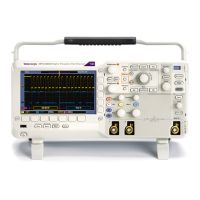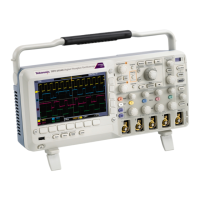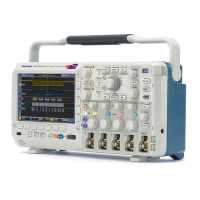Do you have a question about the Tektronix DPO2012B and is the answer not in the manual?
| Brand | Tektronix |
|---|---|
| Model | DPO2012B |
| Category | Test Equipment |
| Language | English |
Safety precautions related to fire and personal injury hazards.
Importance of grounding for safety and accurate measurements.
Adhering to product ratings to prevent fire or shock hazards.
Warning against touching exposed connections and components when power is present.
Ensuring adequate ventilation for the product as per installation instructions.
Details on Electromagnetic Compatibility (EMC) standards the instrument complies with.
Details on safety standards and certifications, including Low Voltage Directive.
Information about product end-of-life handling, recycling, and hazardous substances.
Steps and recommendations before installing the oscilloscope and checking accessories.
List of standard accessories included with the oscilloscope and their part numbers.
List of optional accessories available for the oscilloscope with part numbers.
Operating specifications like voltage, power consumption, weight, and dimensions.
Specifications for the TPP0200/TPP0100 passive voltage probe.
Details on the TekVPI interface for probe communication and control.
Information on the digital probe interface for MSO2000B series oscilloscopes.
Procedures for grounding the oscilloscope and user for safety.
Steps for a basic functional check of the oscilloscope's operation.
Procedure to compensate passive voltage probes for accurate measurements.
Steps to change the language of the user interface and front-panel labels.
Procedure to set the oscilloscope's internal clock to the current date and time.
Steps to perform Signal Path Compensation for DC accuracy and drift correction.
Instructions for downloading and installing firmware updates via USB.
Procedures for setting up analog channels to acquire signals.
Using the Autoset function for automatic oscilloscope setup.
Explanation of signal sampling, digitization, and waveform record creation.
Explanation of FilterVu, Glitch Capture, and Average acquisition modes.
Description of Roll mode for viewing low-frequency signals like a strip chart.
Definition of trigger events, modes, holdoff, and coupling.
Steps to select different trigger types like Edge, Pulse Width, Logic, and Bus.
Detailed descriptions of various trigger types and their conditions.
Steps for configuring the oscilloscope to trigger on various bus types.
How to add or remove waveforms from the oscilloscope display.
How to adjust waveform display style, persistence, and graticule.
Using horizontal and vertical controls to adjust waveform scale and position.
How to set coupling, invert, bandwidth, and probe parameters.
Steps for taking automatic measurements like frequency, period, and amplitude.
How to use on-screen cursors for manual measurements of time and amplitude.
How to create math waveforms by combining source data for analysis.
How to use FFT to analyze signal frequencies and components.
How to mark and search for specific points or regions in waveforms.
How to save the oscilloscope screen image in various formats.
How to save and recall waveform data (numeric values) to files or memory.
How to save and recall oscilloscope configurations and settings.
Steps to connect a printer and configure print settings for hard copies.
Using TekSecure to securely erase oscilloscope memory contents.
Overview of optional application modules and their benefits for serial bus analysis.
Specified analog bandwidth across different models and temperature ranges.
Specification for the oscilloscope's DC coupled input impedance.
Threshold accuracy specification for digital channels on MSO2000B series.











